Sh. T. Niyozov, A. T. Jurabekova
Samarkand State Medical Institute, Samarkand, Uzbekistan
Copyright © 2022 The Author(s). Published by Scientific & Academic Publishing.
This work is licensed under the Creative Commons Attribution International License (CC BY).
http://creativecommons.org/licenses/by/4.0/

Abstract
Favorably ending encephalitis in childhood, may in the long term be manifested by a neurological deficit in the form of mnestic and sensory insufficiency. The transition from acute neuroinfection to a chronic state depends on dysfunctions of the limbic region of the brain, and the timely use of etiotropic treatment received in the early stages will prevent severe complications. Such a drug is cerebrоlysin, and an improved method in the form of ozonation of the drug cerebrоlysin will enhance its effect and reduce the rehabilitation period.
Keywords:
Children, Sequelae of encephalitis, FIM scale, Neuroimaging, Ozonized cerebrolysin
Cite this paper: Sh. T. Niyozov, A. T. Jurabekova, Analysis of the Results of Treatment of Children with the Consequence of Encephalitis, American Journal of Medicine and Medical Sciences, Vol. 12 No. 4, 2022, pp. 390-395. doi: 10.5923/j.ajmms.20221204.05.
1. Introduction
Among all neuroinfections, the proportion of acute viral encephalitis is in the range of 20-30% and according to World Health Organization (WHO) data, 75% of children under the age of 14 are meningitis, encephalitis [1,3,7]. Even a favorably ended encephalitis (Enph) or meningoencephalitis (MEnph) in the future may result in a neurological defect in the form of a limitation of the mnestic and sensory sphere in children. It is the transition of acute neuroinfection into a chronic state that is a factor in the development of disorders of the functioning of the limbic region of the brain [4,6,9]. The term neurological symptoms deficiency, or focal neurological deficit, means a local lesion of one of the structures of the nervous system, which is detected by topical diagnostics and evidently determines the area of damage. So, the definition of the limbic system has the concept of a memory disorder, and correspond to certain symptoms. Loss of long-term memory and skills, for example, a child who used all the skills in everyday life, such as washing, brushing teeth, self-service, loses these skills under the influence of the limbic system collapse. The same applies to the loss of emotions, for example, an early child clearly knew when to enjoy good moments, and when to get upset after a violation of the limbic system, the border is lost and the child is emotionless. The most important symptom is the loss of the ability to be responsible for their behavior, the child does not orient himself, does not know why he makes certain movements, hardly perceives learning new or lost skills. The course and outcome of the disease is affected by the timely use of etiotropic treatment. From the Greek translation, etio means the cause, and tropos means a turn or change, that is, etiotropic treatment, treatment is aimed at the cause of the disease. This paper examines the consequences of acute encephalitis (meningoencephalitis) caused by a viral infection. During the period 2010-2021, more than 200 children and adolescents studied for this disease in the Samarkand region. A larger percentage of which fell on the city of Samarkand and Surgut district (taking into account the population). Etiotropic treatment in the acute period was studied by retrospective analysis, since this work uses the category of children and adolescents with the consequence of encephalitis. In the acute period, patients received prescriptions included in standard therapy, these are broad-spectrum antibiotics (having access to the blood-brain barrier); antiviral therapy (acyclovir); immunomodulatory drugs (interferon-alpha); corticosteroids; symptomatic therapy (anticonvulsants, etc.). At the time of chronization of the process, treatment was mainly aimed at recovery impaired signs, neuroprotection (nootropics, cholinfasterate, vitamin therapy, physiotherapy, etc.). Treatment was carried out by courses of inpatient and outpatient treatment. This work includes patients where previously performed treatment proved ineffective, respectively there is no guarantee of complete recovery of the patient, which is probably due to the influence of highly virulent, mutant and resistant strains of the virus on the process of disorders of the nervous system. In 2005, Veinberga drew attention to the drug cerebrolysin, which, in his opinion, prevents the toxicity of stimulating neurons, improves neuroimmune and neurotransmitter indicators, as well as stabilizes neurophysiological parameters [2,5,8]. In the world medical practice, methods of improving the effectiveness of the drugs used are widely used, one of such methods of therapy is ozonation of drugs, first of all, as a safe method, secondly, interaction with ozone, drugs decrease in toxicity, increasing their own effectiveness, improves the transport function of blood and oxygen supply to ischemic tissues, restores energy formation in cells. Thus, the relevance of the work is to improve the method of treatment of encephalitis in the long term.
2. Aim of Investigation
To evaluate the effectiveness of treatment of the consequences of encephalitis in children with ozonated cerebrolysin.
3. Materials and Study Design
The study is based on a clinical and neurological examination of children with the consequence of encephalitis (Enph) of 144 children, 53 of them girls, 91 boys. The work was performed on the basis of the 1st clinic of Samarkand State Medical Institute in the Department of Pediatric Neurology for the period 2015-2021. The diagnosis of encephalitis was made on the basis of generally accepted criteria in accordance with the classification of ICD-10 (WHO, 1992). The degree of neurological deficit was assessed on the FIM scale (A measure of functional independence (1979)), and this scale was used to assess the effectiveness of rehabilitation treatment. The total score on the FIM scale was from 18 to 126 points, the lower the level; the greater the degree of dependence on others in everyday life, the normal indicator corresponds to 110-126 points. In addition to the standard clinical and neurological examination, with a preliminary thorough history, patients underwent dynamic neuroimaging (MRI studies), electroencephalography if necessary. The patients were divided into groups: group I received traditional therapy and comprised 57 children, group II received treatment with ozonated cerebralisin (OC) and comprised 87 children. The patients took 5-6 courses of OC, each course of 10 receptions of OC. In addition, the patients were divided into subgroups depending on the age of the disease (I subgroup of 4-6 years, and II subgroup of more than 6 years).At the time of examination of patients with the consequence of encephalitis, with signs of focal neurological disorders, in addition to motor lesions, gross cognitive shifts. Thus, etiotropic treatment was aimed at solving this problem. In this regard, treatment with the drug cerebrolizin was proposed – where the active fraction is represented by a peptide; this neuropeptide penetrates through the hemato-encephalitic barrier due to its low mass and goes directly to the nerves, thereby providing neuroprotection, neuromodulation and neurotrophic activity. Without stopping on the achieved results, taking into account the fact that the use of cerebrolizine had previously taken place, experimental work was carried out (on mice and separately laboratory work on spectrometry (dissertation work of Niyazov Sh.T., 2021)), where it was found that individual amino acids in the preparation of cerebrolizine become more active if this drug is carried out previously through an ozonator (that is, ozonation), which improves mainly the amount of methionine, which has a cytoprotective effect and affects the mechanism of nerve cell repair and synthesis of nucleic acids and proteins. This study, conducted in certain stages with the study of the level of effectiveness from the time of the drug and from the amount of the drug administered, formed a scheme of phased application of ozonated cerebrolisin, divided into courses and the number of receptions. The drug itself has a place of affordable production, elementary in pharmacies, but the ozonation of cerebralisin requires a certain device "Ozonator”, with which an ozone-oxygen gas mixture is passed through a bottle with a capacity of 100 ml of 0.9% sodium chloride solution and cerebrolisin for 15-20 minutes.The evaluation of the analysis of a clinical study of pediatric patients with the consequence of encephalitis found that 35.8% of the examined girls and 64.2% of boys, respectively, where the predominance of the male sex is visible. The ratio of boys and girls was 3.5:1. However, the task of this study was not to study the features of the clinic and diagnosis in the gender difference, therefore, further observation does not have a division by gender, and unlike this indicator, it is also important to divide into groups according to the duration of the period from acute to the moment of examination described in the results of their own research.
4. Results
Clinical signs in children with consequences of encephalitis are presented in Table 1.Table 1. Clinical and neurological signs in children with the consequence of encephalitis. Frequent clinical signs in children with consequences of encephalitis
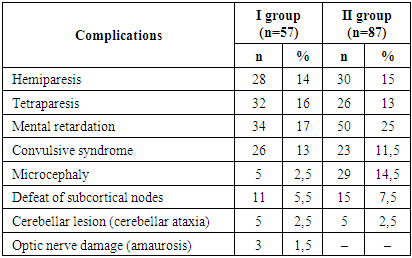 |
| |
|
For ozonation of cerebralisin, the device "OZONATOR 0-1" was used, where an ozone-oxygen gas mixture is passed through a vial with a capacity of sodium chlorine and cerebrolisin (15 min.). Before this solution (ozonated cerebrolisin) was used in children, this study went through long stages – experimental, the pharmacocomitet approved the treatment method, and only after receiving effective treatment on a small group of children, there is the possibility of research on a wider scale.When interpreting the results of the above indicators in children of subgroup I (the limitation period of morbidity from 4 to 6 years), independent eating (without the help of parents), bringing food to the mouth and swallowing in children in group I was on the FIM scale, before treatment, in 7 patients (4.4±0.40 points), after treatment, this indicator increased by 3 patients, and on the scale was 4.7±0.33 points. In group II, this indicator improved after the use of OC with traditional treatment, 27 patients had an independent meal. According to the FIM scale, it was 5.0±0.10 points, respectively. When brushing teeth, combing, washing face and hands, washing and wiping the body, using toilet paper, in group I, 4 patients were noted to independently perform the above skills. When comparing these indicators in children of group II, there is progress in a positive direction and on the FIM scale was 4.2±0.13 and 4.1±0.12 points, comparatively.Assessing motor functions in this subgroup, the average score of the above parameters was: in the I – group before treatment 3.8±0.15 after treatment 4.0±0.17 points, in the II – group before treatment 4.0±0.17, after treatment 4.4±0.13 points, where 3 (18.8%) patients and in group II 4 (22.2%) had hemiparesis and tetraparesis in group I 4 (25%) and in group II 5 (23.8%) patients. After treatment, hemiparesis persisted in group I, and light active movements appeared in 2 patients with tetraparesis. In group II, 1 (4.8%) patient had mild hemiparesis, and patients could walk independently without assistance, according to the FIM scale, this was 5.1±0.14 points. Out of 5, 1 (10.6%) patient with tetraparesis had decreased muscle tone, he began to walk without assistance. According to the FIM scale, movement in group I after treatment was 3.9±0.36 points and in group II 4.5±0.22 points. In patients after treatment with the traditional method, recovery was revealed by 7.2%, and in children in group II by 11.2%.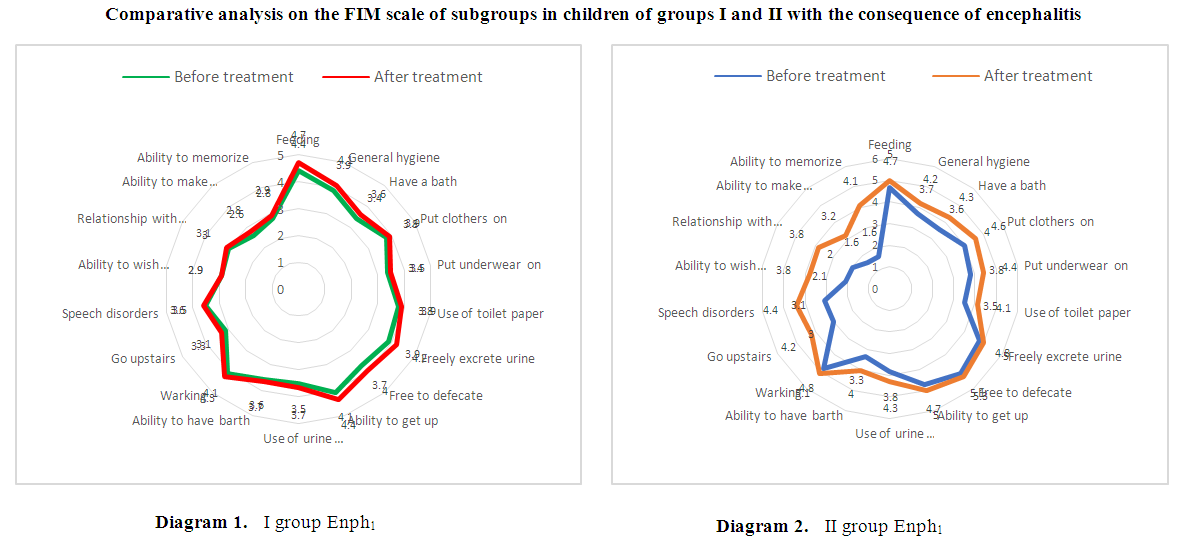 | Diagram 1 and 2 |
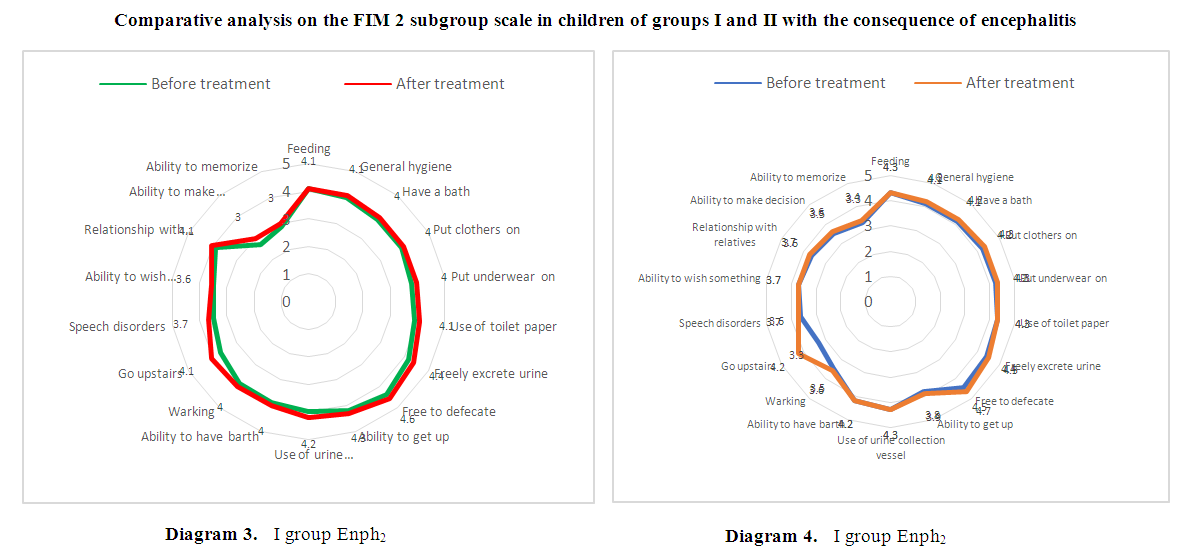 | Diagram 3 and 4 |
Cognitive development lag was 22 (59.5%) patients (in group I, 10 (62.5%), and in group II, 12 (57.1%)). After traditional treatment, 9 patients had impaired attention and speech comprehension, interaction with family members, medical staff, the ability to play with toys, bring their own things, were preserved. Only one patient (6.3%) added several words in speech, according to the FIM scale it was 3.1±0.14 points. When using OC with traditional treatment, the patients' intelligence improved more significantly compared to treatment with traditional methods. In 5 (23.8%) patients, the understanding of speech improved, the verbal base increased. The condition improved from severe to relatively satisfactory and was assessed on a scale of 3.9±0.20 points.The diagram shows that in subgroup 2, the changes after treatment are not satisfactory enough. This is due to the fact that the duration of the disease is more than 6 years after the transfer of Eph in the brain, all neurons in the affected area are inactivated and it is impossible to maintain their operability. The indicators on the scale have minimal differences in the I and II groups of patients. According to the score, they were 4.0±0.04 before treatment in group I and 4.1±0.04 after treatment, and 4.2±0.02 and 4.3±0.03 respectively in group II.We obtained relatively better indicators in the group of patients who received traditional therapy with intravenous administration of OC. With initially equal points in group II, improvement in food intake, personal hygiene, and dressing was noted as early as 2 months after treatment (4.9 and 5.0 points, respectively). In group I, these values were much lower, and amounted to 4.4 points on the FIM scale for 3-4 months of treatment, which was 1.5 points less than in group II. At month 3, the severity of motor function in group II was 4.9±0.02 points, respectively, while in group I patients it corresponded to 2.8±0.16 points. Thus, the use of ozone therapy improved the work and strength of the arm muscles in group II patients with a consequence of Enph from 4.8±0.06 points to 9.8±0.17 points.Cognitive development lag was 18 (40.9%) patients. After traditional treatment in 7 patients, attention to speech comprehension, interaction with family members remained impaired. Only in one patients (4.8%) added a few words in speech, the scale score was 3.5±0.21 points. When using OC with traditional treatment, the patients' intelligence improved, in 10 (23.8%) patients, the understanding of speech improved, the verbal base increased, and was evaluated on a scale of 3.6±0.06 points.Thus, the use of OC has shown efficiency in all parameters. However, it is recommended to start using this method as early as possible, due to the fact that over time the neurons in the affected area are completely intact. In all the subgroups who received OC, there was a better recovery of the above functions, which allows us to recommend its inclusion in the treatment regimen of patients who underwent Ef in order to regress the consequences and reduce the time of rehabilitation of children.In the group of children who underwent Enph 4-6 years ago, before treatment, the frequency of the τ-rhythm was significantly high compared to the other rhythms in both groups 112,4±0,91; 100,8±0,60; 100,8±0,60; After treatment, the indicators of the heart rate decreased to 81.3±0.98 in the first group, and in the second the indicator was 57.5±0.58. Table 2. The EEG index of subgroup I in patients of group I and II with the consequence of encephalitis
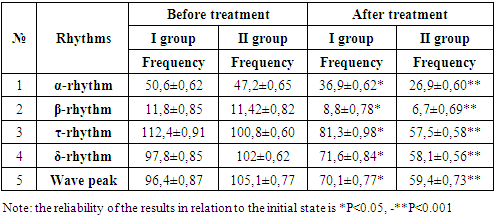 |
| |
|
Table 3. The EEG index of subgroup II in patients of group I and II with the consequence of encephalitis
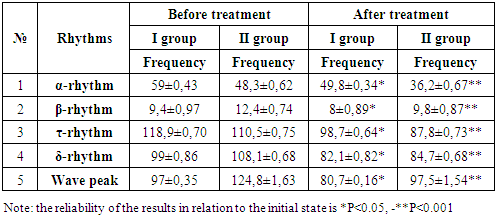 |
| |
|
In dynamics, the decrease in the frequency of the δ-rhythm, after treatment in group II, the indicator decreased 102±0.62 by two times, the interpretation of the results indicates an approximation to normal indicators than in group I (58.1±0.56). In children with convulsive syndrome, the frequency of the peak wave decreased in group I: 96.4±0.87 by 70.1±0.77. In group II, the results obtained show a decrease in indicators by 2 times from 105.1±0.77 to 59.4±0.73.In the group of children who underwent Enph with a prescription period of more than 6 years ago, before treatment, the frequency of the τ-rhythm is significantly high, compared to the other rhythms in both groups of 118.9±0.70; 110.5±0.75. After treatment, the indicators of the heart rate decreased slightly in I - 98.7±0.64 and in II groups 87.8±0.73. In addition to positive dynamics, the children who underwent the course of traditional treatment with OC, according to clinical signs, found adequate and effective results on the MRI picture. In 28 children (65.1%) with group 2 of the consequences of encephalitis, subgroup 1 (II g Enph1) and in 8 children (66.7%) with group 2 of the consequences of meningoencephalitis, subgroup 1 (II g MEnph1), a decrease in atrophic processes is clearly visible in the MRI picture. If, before treatment, inflammatory cerebellar atrophy was detected in 5 (11.6%) patients with II g Enph1 and 3 (25%) children with II g MEnph1, then after treatment 6 months later, 4 patients with II g Enph1 and 2 (16.7%) children with II g MEnph1, cerebellar atrophy recovered by 55-65%, respectively, only 1 (2.3%) patients with II g Enph1 retained a mild atrophic process.In 12 patients (27.9%) with II g Enph1 and in 4 patients (33.3%) with II g MEnph1, as a result, signs of edema of the brain substance in the form of narrowing of the ventricles of the brain, a decrease in the density of the brain substance. In 11 (25.6%) patients with II g Enph1 and 3 (25%) with II g MEnph1, an MRI study after treatment revealed unclear focuses of increased signal intensity, visualized on FLAIR images in T1 mode in the cortex of the parietal lobes, interpreted as residual changes in the inflammatory process, which were not determined upon repeated examination after 6 months.A porencephalic cyst was found in the brain in 7 (16.3%) patients of II g Enph1, and in 1 patient (8.3%) with II g MEnph1. Treatment after 6 months in 6 patients with II g Enph1 and in 1 patient (8.3%) with II g MEnph1 showed a decrease in cyst volume.In children with a disease duration of more than 6 years, atrophy of the brain structure is more concentrated in the cerebellum, 3 patients (14.3%) with II group of consequences of encephalitis, subgroup 2 (II g Enph2) and 2 patients (25%) with II group of consequences of meningoencephalitis, subgroup 2 (II s MEnph2), respectively. After the traditional treatment with OC, 2 patients (9.5%) with II s Enph2, and 2 patients (25%) with II s MEnph2 retained an atrophic process in the cerebellum. Only in one patient with consequences of encephalitis of the second subgroup cerebellar atrophy was marked by mild positive dynamics.We managed to calculate the economic effect in monetary terms in the department of pediatric neurology of the regional children's multidisciplinary medical center. The cost of one day of a sick child's stay in a hospital with traditional treatment: hospital stay – free, meals – free, medicines – 27,000 sums, tests – 6000 sums. The total amount of expenses per day is 33,000 sums. For 15 days – 495,000 sums.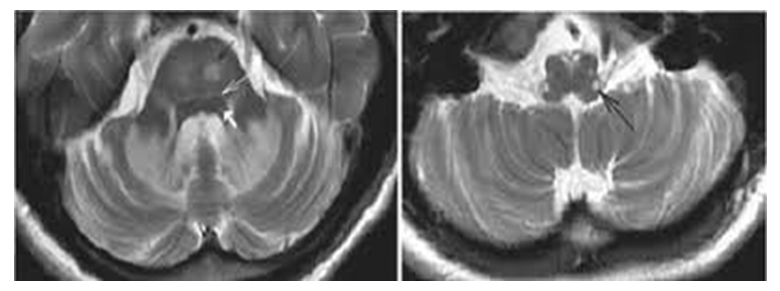 | Figure 1. MRI picture T2 mode. Light atrophic process of cerebellar hemispheres |
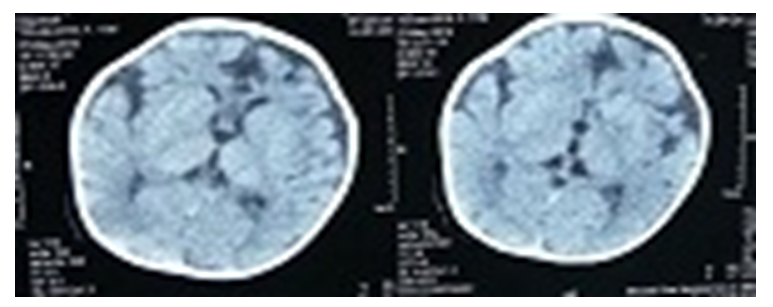 | Figure 2. MRI picture, T1 mode, unclear focuses of increased signal intensity |
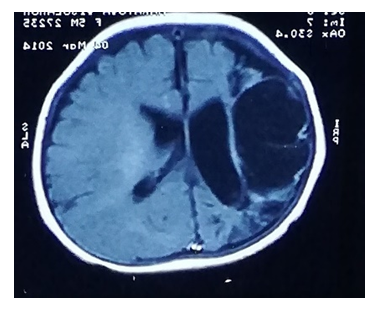 | Figure 3. MRI picture, T1 mode. Porencephalic cyst of large size |
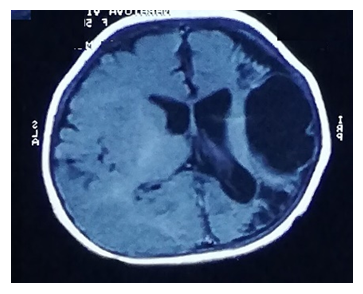 | Figure 4. MRI picture, T1 mode, after treatment, the porencephalic cyst fit in size |
The cost of one day of a sick child's stay in a hospital with complex modified treatment: hospital stay – free, meals – free, medications – 18,000 sums, tests – 6000 sums. The total amount of expenses per day is 24,000 sums. The course of treatment is no more than 10 days – 240,000 sums. Reducing the patient's stay (with a complication of encephalitis with the use of complex modified treatment) in the hospital for 5 days leads to a reduction in costs per 1 patient by 255,000 (51.5%) sums.
5. Conclusions
Thus, the results of analyses before and after treatment of children with the consequence of encephalitis, according to neuroimaging images, showed characteristic changes depending on the prescription of the disease, age, timing of treatment and features of additional therapy, in particular the administration of ozonated cerebrolysin. So, if the use of traditional therapy in the long-term period forms pathological focuses with porencephalic cysts, cortical atrophy with calcifications in the projections of subcortical nuclei, hydrocephalic enlargement, with impaired microcirculation and a tendency to progression. Then, in cases of using traditional treatment with ozonated cerebrolysin at the same time, there is a clear picture of the effectiveness of the absence of inflammatory edema from the brain substance, the restoration of inactive neurons around the inflammatory focus of the brain, diffuse cortical atrophy persists in insignificant percentages, as well as hydrocephalus, with a predisposition to complete restoration of pathological lobular processes.
References
| [1] | Belova A.N., Grigorieva V.N., Rasteryaeva M.V. Anti-NMDAR encephalitis with recurrent optic nerve damage // Journal of Neurology and Psychiatry named after S.S. Korsakov 2020, vol. 120, № 6, P. 105-113. |
| [2] | Grigorieva O.O., Sheik Zh.V., Karmazanovsky G.G., Dunaev A.P., Drebushevsky N.S., Danchenko I.A., Esin E.V., Bashkov A.N. Computer and magnetic resonance imaging in the diagnosis of herpetic encephalitis (clinical observation) // Journal of Publication № 4, Moscow 2015. – P. 31-38. |
| [3] | Gromova O.A., Torshin I.Yu., Gogoleva I.V. The peptide composition of cerebrolysin as the basis of molecular mechanisms of action and clinical efficacy of the drug. // Journal of Neurol and Psychiatrist. – 2014. – № 1. – P. 29-35. |
| [4] | Penkina Yu.A. Microcapsulation of ozonides of triglycerides of unsaturated carboxylic acids by the method of complex coacervation // dissertation of PhD, Moscow 2011; P. 16. |
| [5] | Rogozina N.V., Vasiliev V.V., Grineva A.A., Mikhailov A.V., Kashtanova T.A., Ante- and postnatal diagnostics and complex treatment of congenital cytomegalovirus infection // Journal of Russian Bulletin of Perinatology and Pediatrics. – 2019. – № 64(6) – P. 89-93. |
| [6] | Skripchenko N.V., Vilnits A.A., Skripchenko E.Yu., Ivanova M.V. Karasev V.E., Goreliko E.Yu., Bukhalko M.A. Neuroinfections in children in modern conditions // Journal of Practical Medicine, St. Petersburg, 2017. – P. 8-18. |
| [7] | Aydos, U., Arhan, E., Akdemir, Ü. Ö., Akbaş, Y., Aydin, K., Atay, L. Ö., & Serdaroğlu, A. (2020). Utility of brain fluorodeoxyglucose PET in children with possible autoimmune encephalitis. Nuclear Medicine Communications, 41(8), 800-809. |
| [8] | Bastard P. et al. Herpes simplex encephalitis in a patient with a distinctive form of inherited IFNAR1 deficiency // The Journal of Clinical Investigation. – 2021. – Vol. 131. – №. 1. |
| [9] | Haston J.C. et al. Prospective cohort study of next-generation sequencing as a diagnostic modality for unexplained encephalitis in children // Journal of the Pediatric Infectious Diseases Society. – 2020. – Vol. 9. – №. 3. – P. 326-333. |








 Abstract
Abstract Reference
Reference Full-Text PDF
Full-Text PDF Full-text HTML
Full-text HTML

